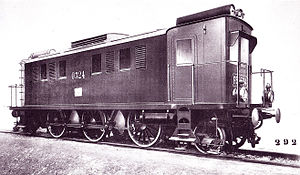FS E.320
| FS E.320 | |
|---|---|
| Numbering: | E.320.001-005 |
| Number: | 5 |
| Manufacturer: | mechanical Officine Meccaniche electrical TIBB |
| Year of construction (s): | 1915-1918 |
| Retirement: | k. A. |
| Axis formula : | 1'C1 ' |
| Gauge : | 1435 mm ( standard gauge ) |
| Length over buffers: | 12,770 mm |
| Total wheelbase: | 10,000 mm |
| Service mass: | 71.8 t |
| Friction mass: | 46.8 t |
| Top speed: | 95 km / h |
| Hourly output : | 1,500 kW |
| Continuous output : | 1,200 kW |
| Driving wheel diameter: | 1,500 mm |
| Power system : | 650 V DC voltage |
| Power transmission: | direct power transmission from direct current busbar to direct current traction motors |
| Number of traction motors: | 2 |
| Drive: | Helical rod drive with 2 jackshafts |
| Brake: | Handbrake air brake type Westinghouse |
| Particularities: | electric locomotive with power rail |
The E.320 series was an electric locomotive series of the Italian state railroad Ferrovie dello Stato . It was used on the Ferrovie Varesine in the power system with a side power rail . The more successful FS E.321 design was developed from this. The locomotives were retired after a short period of operation. No locomotive has survived.
history
The electrification of the railway in Italy began around 1900. At that time there was the northern Italian three-phase network , an unsuccessful attempt with accumulator railcars and operation with direct voltage of 650 V and busbars on the Ferrovie Varesine from Milan to Varese .
The locomotives were built from 1912 and were used on the line from 1915. They were designed as box locomotives with two driver's cabs at the top. The running axles were combined with the neighboring coupling axle to form a Zara frame . The middle driving axle had side play. The torque was transmitted from the two motors via connecting rods to two jackshafts mounted next to the central drive axle and from there via coupling rods to the other drive wheels. The drive design proved to be unsustainable and led to several breaks, which is why the successor version was designed with lower-lying motors and triangles as with the three-phase locomotives. All coupling wheels had a block brake on both sides . The main air tanks were located on the roof of the locomotive. Several roof segments and the middle part could be removed from the box in order to be able to dismantle the drive motors.
The two traction motors were connected in series . The drive switch was located in the middle of the engine room and could be switched from the driver's cabs with the help of a continuous shaft. The main switch and the reversing switch were switched pneumatically. The current was picked up by means of eight grinding shoes, four of which always had to be present so that a current of 3.2 kA could still be picked up at a speed of 95 km / h .
The vehicles had a performance characteristic according to which trains with a load of 200 t could be transported on slopes of 12 per thousand at 80 km / h without any problems. This showed their area of use for the carriage of passenger trains on the Ferrovie Varesine. Stationing data about the vehicles is missing. It was only mentioned that the locomotives were soon withdrawn from service due to their unfavorable drive design.
See also
literature
- Wolfgang Messerschmidt: History of the Italian electric and diesel locomotives . Orell Füssli Verlag, Zurich 1969.
